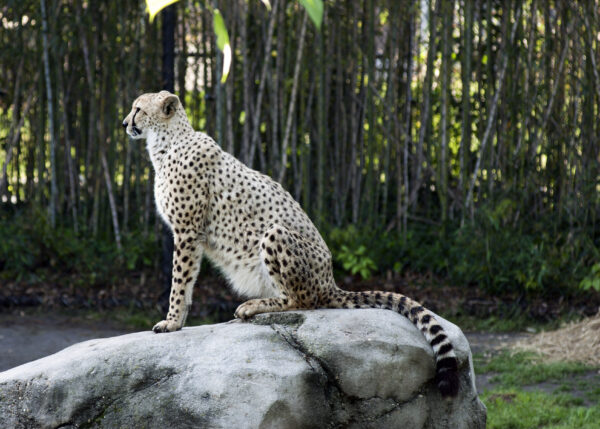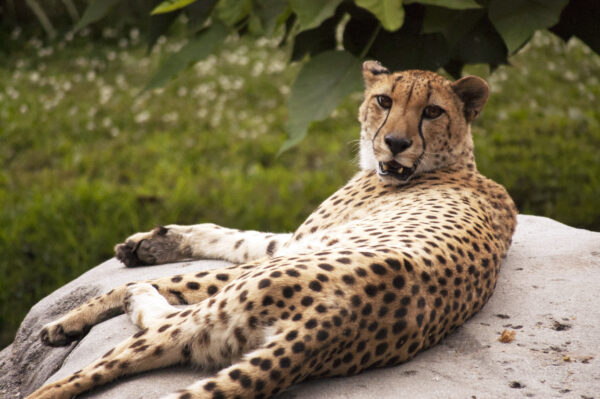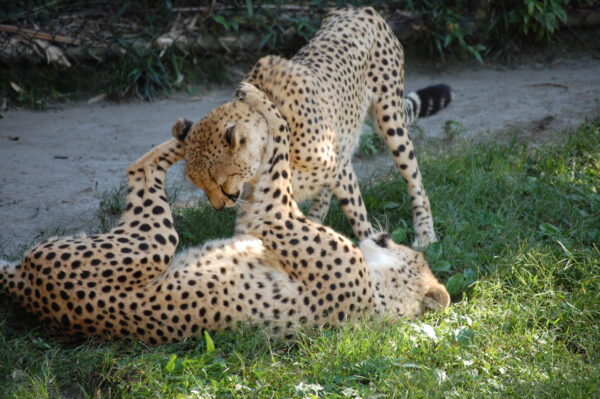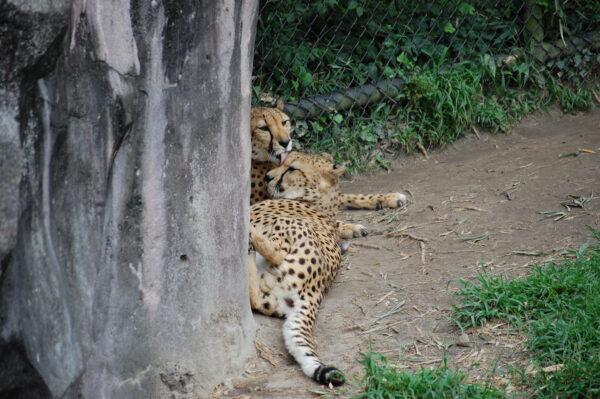They’ve Been Spotted
You probably already know that a cheetah can run from 0-60 miles per hour in under three seconds, which is much faster than the average car, but let’s take a few moments to slow down and learn more interesting facts about these magnificent creatures, including the two cheetahs found right here at the Virginia Zoo.
The cheetah (Acinonyx jubatus) is found in parts of eastern and southwestern Africa, as well as parts of Iran. These unique cats are distinguished by their slender tan bodies, which are cloaked in black spots from head to tail.

Cheetahs have beautiful orange-red eyes and black “tear marks” that run from the inside corners of their eyes down to the outside edges of their mouth. These marks help reflect the glare of the sun when they are hunting during the day and work just like the black marks that football players put under their eyes during the games.
Despite its speed and ability to camouflage thanks to its unique coloration, the cheetah has become Africa’s most endangered cat and is vulnerable to extinction. Almost two decades ago, there were more than100,000 cheetahs. Today less than 10,000 cheetahs still exist. The decline in their population is due to several reasons.

Poaching is not a major issue but does occur. Baby cheetahs are often captured and illegally sold into captivity, while the mother is killed. Disturbances in the balance of nature also has an impact on the population of cheetahs and wildlife in general. Too little rain can affect how dry the land is, and as a result, fires can break out more easily and wipe out everything that is living.
Habitat loss is another issue cheetahs face. Native encroaching thornbush is overtaking much of the cheetahs’ natural habitat. The dense bush grows rapidly and is extremely thorny, which makes it impossible for cheetahs and their food sources to thrive in.
The biggest issue for cheetahs is that the land they live on is also inhabited by privately-owned livestock. Cheetahs are natural predators, and it is common for them to prey on livestock, such as goats. As a result, human interference harms the cheetahs. Farmers often set traps on their land in which the cheetahs are caught and killed.
There are several organizations that have various methods for helping save cheetahs in the wild. Both Action for Cheetahs in Kenya (ACK) and the Cheetah Conservation Fund (CCF) conduct research and offer awareness and community participation, including education programs. The CCF’s farmer education and Livestock Guarding Dog programs have proven to be successful in combating human-cheetah conflict. You can read more about the CCF’s efforts here.
The Virginia Zoo donates to both cheetah conservation organizations and is often host to representatives from each organization. In 2016, Brian Badger, the director of conservation and outreach with the CCF visited the Zoo with the purpose of educating staff on the Fund’s holistic approaches toward cheetah conservation. For the past two years, Mary Wykstra, the Director of Action for ACK has given lectures about cheetahs to Virginia Zoo guests. You can also see Mary talk about the ACK and see the Virginia Zoo’s cheetahs in this video.
The Virginia Zoo has two cheetahs. Brothers Chester and Rico were born in a litter of five on October 6, 2013. The pair came to the Virginia Zoo from their birthplace, the Metro Richmond Zoo, in March 2016. Their arrival was the first time the Virginia Zoo would ever have cheetahs on exhibit.

Rico has darker rings around the bottom of his tail than Chester, and also weighs around five pounds more. Other than the slight difference in their appearance, the brothers are a spitting image of each other.
They enjoy doing and eating basically the same things, although Zoo Keepers say Chester is more vocal than Rico. Cheetahs make several vocalizations, but unlike other big cats, “roaring” is not one of them. Instead they chip, purr and hiss.
Chester and Rico are both fed a premium feline diet, which consists of mostly meat with some additionally added nutrients. For enrichment, they love rolling around boomer balls, especially those filled with meaty treats.
A big cat’s favorite thing to do is take a long cat nap, and Chester and Rico enjoy doing just that. They are often found snuggling with each other while napping! When they’re wide awake, they enjoy watching Zoo staff walk in the service area behind their exhibit fence.

Chester and Rico’s exhibit can be found in the Africa – Okavango Delta just beyond the Red River hog exhibit and across from the giraffe yard. Every year, December 4 is International Cheetah Day, so be sure to stop by and say hello on the day that honors and brings awareness to these magnificent creatures!
